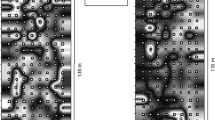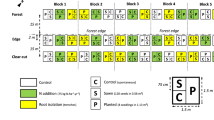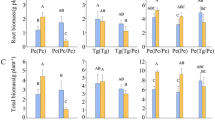Abstract
This study was aimed at determining, under field conditions, early interactions between planted cypress seedlings and their associated shrubs in a mesic area of Andean Patagonia and, in a nursery, the effects of increasing light availability on cypress performance when soil water was not a limiting factor. The field experiment was performed in a former cypress–coihue mixed forest (42°02′S, 71°33′W), which was replaced in the 1970s by a plantation of radiata pine. In 2005, 800 cypress seedlings were planted under maqui shrubs in a clear-cut area of the pine stand. In 2007, two treatments were set: no-competition treatment ([NCT] i.e., the surrounding aboveground biomass was removed) and competition treatment ([CT] i.e., without disturbance). The nursery experiment (42°55′S, 71°21′W) consisted of two groups: “shade” (grown under shade cloth) and “sun” (grown at full sun) cypress seedlings. After one growing season, seedling survival and stem growth (in height and diameter) were determined at both sites. Furthermore, the growth rate of leaves, stems, and roots was determined in the nursery. In the field experiment, height growth and survival in NCT were significantly greater than in CT, and a competition process occurred between cypress and surrounding shrubs. In the nursery, sun plants grew more in diameter and increased root weight more than shade plants. Results also showed that in mesic areas of Patagonia, decreasing competition and increasing light levels produced stouter seedlings better adapted to support harsh environmental conditions. Therefore, the removal of protecting shrubs could be a good management practice to improve seedling establishment.



Similar content being viewed by others
References
Avello Lorca M, Valladares Acosta R, Ordóñez Belmar JL (2008) Capacidad antioxidante de Aristotelia chilensis (Molina) Stuntz. Rev Cubana Plant Med 13(4):1–9
Balzarini MG, Gonzalez L, Tablada M, Casanoves F, Di Rienzo JA, Robledo CW (2008) Infostat: manual del usuario. Editorial Brujas, Córdoba
Bellot J, Maestre FT, Chirino E, Hernández N, de Urbina JO (2004) Afforestation with Pinus halepensis reduces native shrub performance in a Mediterranean semiarid area. Acta Oecol 25(1):7–15
Buduba CG (2006) Modificaciones en el pH y contenido de materia orgánica en suelos del ecotono estepa/bosque andino patagónico por implantación de pino ponderosa. Doctoral thesis. Universidad Nacional de Buenos Aires, Buenos Aires.
Bustos JC, Rocchi VC (1993) Caracterización termo-pluviométrica de veinte estaciones meteorológicas de Río Negro y Neuquén. Informe Técnico, INTA-EEA, Bariloche
Callaway RM (1995) Positive interactions among plants. Bot Rev 61:309–349
Callaway RM, Walker LR (1997) Competition and facilitation: A synthetic approach to interactions in plant communities. Ecology 78(7):1958–1965
Callaway RM, Brooker RW, Choler P, Kikvidze Z, Lortie CJ, Michalet R et al (2002) Positive interactions among alpine plants increase with stress. Nature 417:844–848
Carpenter FL, Nichols JD, Sandi E (2004) Early growth of native and exotic trees planted on degraded tropical pasture. For Ecol Manag 196:367–378
Chambers JC, Vander Wall SB, Schupp EW (1999) Seed and seedling ecology of Piñon and Juniper species in the pygmy woodlands of Western North America. Bot Rev 65:1–38
Clewell AF (2000) Restoration of natural capital [editorial]. Restor Ecol 8(1):1
Dezzotti A, Sancholuz L (1991) Los bosques de Austrocedrus chilensis en Argentina: Ubicación, estructura y crecimiento. Bosque 12(2):43–52
Ericsson T (1995) Growth and shoot: root ratio of seedlings in relation to nutrient availability. Plant Soil 168–169:205–214
Franco A, Nobel P (1989) Effect of nurse plants on the microhabitat and growth of cacti. J Ecol 77:870–886
Giladi I, Segoli M, Ungar ED (2013) Shrubs and herbaceous seed flow in a semi-arid landscape: Dual functioning of shrubs as trap and barrier. J Ecol 101:97–106
Gobbi M (1999) Austrocedrus chilensis management: effects on microsites and regeneration. Int J Ecol Environ Sci 25:71–83
Gyenge JE, Fernández ME, Dalla Salda G, Schlichter T (2005) Leaf and whole plant water relations of the Patagonian conifer Austrocedrus chilensis (D. Don) Pic. Serm. and Bizzarri: Implication on its drought resistance capacity. Ann For Sci 62:297–302
Gyenge JE, Fernández ME, Schlichter T (2007) Influence of radiation and drought on gas exchange on Austrocedrus chilensis seedlings. Bosque 28:220–235
Haase D (2008) Understanding forest seedling quality: Measurements and interpretation. Tree Plant Notes 52(2):24–30
Holmgren M, Scheffer M, Huston MA (1997) The interplay of facilitation and competition in plant communities. Ecology 78(8):1966–1975
Holzapfel C, Mahall BE (1999) Bidirectional facilitation and interference between shrubs and annuals in the Mojave Desert. Ecology 80(5):1747–1761
Huber AJ, López D (1993) Cambios en el balance hídrico provocados por tala rasa de un rodal adulto de Pinus radiata (D. Don), Valdivia, Chile. Bosque 14(2):11–18
Kitzberger T, Veblen TT, Villalba R (1997) Climatic influences on fire regimes along a rain forest-to-xeric woodland gradient in northern Patagonia, Argentina. J Biogeogr 24:35–47
Kitzberger T, Steinaker DF, Veblen TT (2000) Effects of climatic variability on facilitation of tree establishment in northern Patagonia. Ecology 81(7):1914–1924
Laclau P (2002) Evaluación financiera de bosques de ciprés de la cordillera (Austrocedrus chilensis). Fundación Vida Silvestre Argentina, Fundación Turner
Letourneau FJ (2006) Estudio de las interacciones positivas y negativas sobre el crecimiento de Austrocedrus chilensis durante una etapa inicial de desarrollo, en un matorral sucesional mésico. Doctoral thesis. Universidad Nacional del Comahue, San Carlos de Bariloche, Argentina
Letourneau FJ, Andenmatten E, Schlichter T (2004) Effect of climatic conditions and tree size on Austrocedrus chilensis–shrub interactions in northern Patagonia. For Ecol Manag 191:29–38
Loguercio GA, Rajchenberg M, Rodríguez N, Pantaenius P (1999) Curso-Taller de actualización en silvicultura de los bosques de ciprés de la cordillera. CIEFAP, GTZ, El Bolsón, Argentina
Maestre FT, Bautista S, Cortina J, Bladé C, Bellot J, Vallejo VR (2003) Bases ecológicas para la restauración de los espartales semiáridos degradados. Revista Ecosistemas 12 (1). www.revistaecosistemas.net/index.php/ecosistemas/article/view/333. Accessed: 27 May 2010
Manfredi R, Urretavizcaya MF, Grosfeld J, Ramilo E, Caracotche S, Arosteguy C, et al. (1999) Plan Estratégico de Manejo de la Reserva Forestal Cuartel Lago Epuyén, Caracterización y Diagnóstico. CFI-CIEFAP-SNAP-DGByP. Esquel, Argentina
Markham JH, Chanway CP (1996) Measuring plant neighbour effects. Funct Ecol 10(4):548–549
McCook LJ (1994) Understanding ecological community succession: Causal models and theories, a review. Vegetatio 110:115–147
Mitchell SJ (2003) Effects of mechanical stimulus, shade, and nitrogen fertilization on morphology and bending resistance in Douglas-fir seedlings. Can J For Res 33:1602–1609
Muñoz A, González ME (2006) Aristotelia chilensis (Molina) Stuntz Familia: Elaeocarpaceae. In: Donoso Zegers C (ed) Las especies arbóreas de los bosques templados de Chile y Argentina. Autoecología. Marisa Cuneo Ediciones. Valdivia, pp 166–172
Nuñez CI, Raffaele E, Nuñez M, Cuassolo F (2009) When do nurse plants stop nursing? Temporal changes in water stress levels in Austrocedrus chilensis growing within and outside shrubs. J Veg Sci 20:1064–1071
Orellana IA (2007) Análisis de la sustentabilidad ambiental de las plantaciones con exóticas en Patagonia. In: EcoForestar—I Reunión sobre Forestación en la Patagonia, April 25–27, Esquel, Argentina, pp 403–406
Pauchard A, Langdon B, Peña E (2008) Potencial invasivo de Pseudotsuga menziesii (Mirb.) Franco en Bosques nativos del centro-sur de Chile: Patrones y recomendaciones. In: Mujica R, Grosse H, Müller-Using B (eds) Bosques seminaturales, una opción para la rehabilitación de bosques nativos degradados. Instituto Forestal, Valdivia, pp 89–114
Pugnaire FI, Haase P, Puigdefabregas P, Cueto M, Clark SC, Incoll LD (1996) Facilitation and succession under the canopy of a leguminous shrub, Retama sphaerocarpa, in a semiarid environment in southeast Spain. Oikos 76:455–464
Puigdefábregas J, Solé-Benet A, Gutiérrez L, Del Barrio G, Boer M (1999) Scales and processes of water and sediment redistribution in drylands: Results from the Rambla Honda field site in Southeast Spain. Earth Sci Rev 48:39–70
Rovere A (2000) Condiciones ambientales de la regeneración del ciprés de la cordillera (Austrocedrus chilensis). Bosque 21(1):57–64
Sala OE, Golluscio RA, Lauenroth WK, Soriano A (1989) Resource partitioning between shrubs and grasses in the Patagonian steppe. Oecologia 81:501–505
Silander JA, Pacala SW (1990) The application of plant population dynamics models to understanding plant competition. In: Grace JB, Tilman D (eds) Perspectives on plant competition. Academic press, San Diego, pp 67–91
Simberloff D, Relva MA, Nuñez M (2002) Gringos en el bosque: Introduced tree invasion in a native Nothofagus/Austrocedrus forest. Biol Invasions 4:35–53
Sokal RR, Rohlf FJ (1979) Biometría. Principios y métodos estadísticos en la investigación biológica. H Blume Ediciones, Madrid
Tielbörger K, Kadmon R (2000) Temporal environmental variation tips the balance between facilitation and interference in desert plants. Ecology 81(6):1544–1553
Todone F (2005) Plan de manejo de las forestaciones de la Provincia del Chubut en la Región del Noroeste. Dirección Gral. de Bosques y Parques
Urretavizcaya MF, Defossé GE (2013) Effects of nurse shrubs and tree shelters on the survival and growth of two Austrocedrus chilensis seedling types in a forest restoration trial in semiarid Patagonia, Argentina. Ann For Sci 70(1):21–30
Urretavizcaya MF, Defossé GE, Gonda HE (2012) Effect of sowing season, plant cover, and climatic variability on seedling emergence and survival in burned Austrocedrus chilensis forests. Restor Ecol 20(1):131–140
Valladares F, Gianoli E (2007) How much ecology do we need to know to restore Mediterranean ecosystems? Restor Ecol 15:363–368
Valladares F, Aranda I, Sánchez-Gómez D (2004) La luz como factor ecológico y evolutivo para las plantas y su interacción con el agua. In: Valladares F (ed) Ecología del bosque mediterráneo en un mundo cambiante. Ministerio de Medio Ambiente, EGRAF S.A, Madrid, pp 335–369
Veblen TT, Kitzberger T, Burns BR, Rebertus AJ (1995) Perturbaciones y dinámica de regeneración en Bosques andinos del sur de Chile y Argentina. In: Armesto JJ, Villagrán C, Kalin Arroyo MT (eds) Ecología de los Bosques Nativos de Chile. Editorial Universitaria, Santiago, pp 169–198
Villalba R, Veblen TT (1997) Regional patterns of tree population age structures in northern Patagonia: climatic and disturbance influences. J Ecol 85:113–124
Villalba R, Holmes RL, Boninsegna JA (1992) Spatial patterns of climate and tree growth variations in Subtropical Northwestern, Argentina. J Biogeogr 19(6):631–649
Waring RH, Schlesinger WH (1985) Forest ecosystems. Concepts and management. Academic press, New York
Zou CB, Breshears DD, Newman BD, Wilcox BP, Gard MO, Rich PM (2008) Soil water dynamics under low- versus high- ponderosa pine tree density: Ecohydrological functioning and restoration implications. Ecohydrology 1:309–315
Acknowledgments
We thank M. Florencia Oyharçabal, Daniela Morales, Luciano Taladriz, Patricio Dowbley, and Juan Monges for field assistance during the study. Part of this work was supported by the program “Restoration of Degraded Native Forests in Chubut Province” financed by the Chubut Province.
Author information
Authors and Affiliations
Corresponding author
Rights and permissions
About this article
Cite this article
Pafundi, L., Urretavizcaya, M.F. & Defossé, G.E. Improving Survival and Growth of Planted Austrocedrus chilensis Seedlings in Disturbed Patagonian Forests of Argentina by Managing Understory Vegetation. Environmental Management 54, 1412–1420 (2014). https://doi.org/10.1007/s00267-014-0363-2
Received:
Accepted:
Published:
Issue Date:
DOI: https://doi.org/10.1007/s00267-014-0363-2




